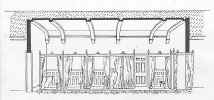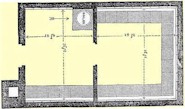8: Turkish baths for special needs

From the earliest days of the Victorian Turkish bath, provision was made for three special categories of bather: hospital patients, the mentally ill in asylums, and animals, especially cattle and racehorses.
In 1860, Sir John Fife installed the first Turkish bath in an English hospital at the Newcastle-on-Tyne Infirmary where, according to the hospital’s annual reports, it remained in use until the end of the century.126 And Leared has described how, in 1861, after encouraging results from trials with 20 phthisis (tuberculosis) patients in the not yet completed London Hammam, Urquhart installed a Turkish bath at the Brompton Consumptive Hospital.127
The first recorded use of the Turkish bath in the treatment of mental illness was also in 1861. Articles describe its tentative use under Dr Power, resident doctor at the Cork District Lunatic Asylum,128 and under Dr Lockhart Robertson at the Sussex County Lunatic Asylum at Haywards Heath.129
By 1864, Dr Bryce was reporting to the Medical Society that,
Every lunatic asylum in Ireland, several in Scotland, and some in England, furnish the profession with the means of experimentally testing the virtues of the bath; and the result herein is, I am assured, uniformly affirmative. Many civil hospitals also possess them, and now Netley Military Hospital has provided one.130
While there is, so far, no other evidence to corroborate the spread of the bath to every asylum in Ireland, it is undoubtedly true that the Turkish bath was speedily adopted in many Victorian asylums. Modern sensibilities may wonder at the means of its experimental use on the mentally ill. It is clear, however, that the patients themselves favoured it and, where previously the alternative had been a hosing down by an attendant, they found the Turkish bath restful and, perhaps more important, totally unthreatening.
 In 1877, Robert Baker installed one at The Retreat in York. Ten years later this was still being successfully used with a wide range of patients, both as a curative agent and as a palliative.132 It may be a significant factor in patients' acceptance of the Turkish bath that, as in other hospitals such as the Newcastle Infirmary, the bath was also open for separate sessions by both nursing staff and members of the public.133 The bath at The Retreat cost just under £1,400 to build and somewhere between nine
shillings and eleven shillings per week to heat.131
In 1877, Robert Baker installed one at The Retreat in York. Ten years later this was still being successfully used with a wide range of patients, both as a curative agent and as a palliative.132 It may be a significant factor in patients' acceptance of the Turkish bath that, as in other hospitals such as the Newcastle Infirmary, the bath was also open for separate sessions by both nursing staff and members of the public.133 The bath at The Retreat cost just under £1,400 to build and somewhere between nine
shillings and eleven shillings per week to heat.131
Turkish baths for animals
In 1859, Robert Wollaston visited St Ann’s Hydropathic Establishment. Noting that in addition to the patients’ baths (also used by those who worked at the hydro) and one specially erected for the poor of the area, Dr Barter had built special baths for sick horses, cattle, and dogs from the hydro’s home farm. Wollaston wrote of the animals that,
 It is curious to observe with what patience and apparent satisfaction they endure the process of sudorification. Various diseases incidental to domestic animals, besides the distemper and epidemics, have been cured by the hot-air Bath; and I witnessed the curious spectacle of seeing two horses submitted to the process, with the perspiration rolling off their bodies, afterwards washed with tepid water, and then groomed or rubbed down with brushes steeped in cold water. The animals seem always brisk and gay after the operation.134
It is curious to observe with what patience and apparent satisfaction they endure the process of sudorification. Various diseases incidental to domestic animals, besides the distemper and epidemics, have been cured by the hot-air Bath; and I witnessed the curious spectacle of seeing two horses submitted to the process, with the perspiration rolling off their bodies, afterwards washed with tepid water, and then groomed or rubbed down with brushes steeped in cold water. The animals seem always brisk and gay after the operation.134
After Admiral Rous, steward of the Jockey Club, wrote a much-quoted letter to The Field in 1860 on the Turkish bath as a means of training,135 the use of the Turkish bath became quite popular in racing circles. Butterfly (winner of the Oaks in 1860) and Kettledrum (winner of the Derby in 1861) were both trained with the assistance of the Turkish bath.136 It was argued that by this means the horse was sweated while at rest (so that strain on the heart was avoided), and without additional heavy clothing (so that exposure of the pores to the air cleansed the system).137
Pickfords the carriers, built a Turkish bath at their horses’ hospital at Finchley, using one of Constantine’s Convoluted stoves to heat it. It was used three days each week and,
never less than twenty horses per week are put into it, undergoing sweating, washing, and drying again in an out-room.138
It is difficult to imagine today how important horses were to the smooth running of everyday life in the nineteenth century. Simmons has estimated that even as late as 1913, the twelve largest railway companies alone were still using around 26,000 horses, mainly in cartage and shunting.139 Relatively inexpensive facilities which helped to keep working horses working, and in good health, were a good investment.
-o-o-o-o-o-o-o-o-
Acknowledgements
This review is a very slightly amended and updated version of an essay for Professor Gregory Claeys in the 'Introduction to Victorian studies' module of the 1997 Royal Holloway University of London MA in 'Modern History: Power, Culture, Society' (Course Director: Professor Penelope J Corfield).
Thanks are also due to:
The Master and Fellows of Balliol College, Oxford for access to the Papers of David Urquhart;
The Librarian of the Wellcome Institute for access to the Correspondence and papers of David Urquhart and Harriet Angelina Urquhart (Western mss 6236-6240);
The Archivist and staff of the Wiltshire County Record Office, Trowbridge, for help in locating the Poore family papers

